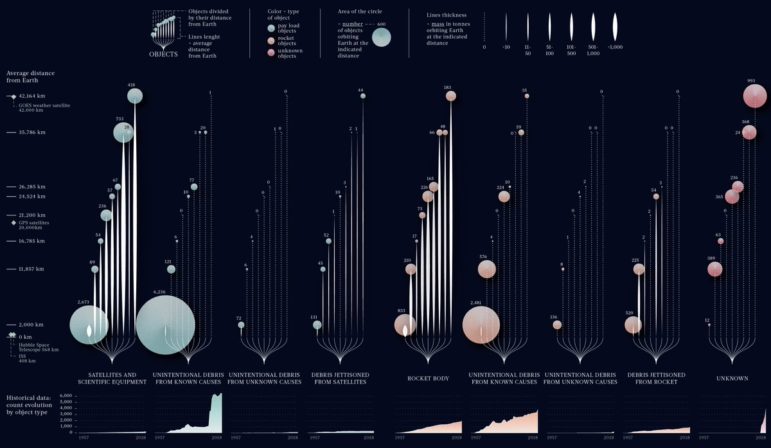

GIJN’s Data Journalism Top 10: The NYT’s Data Curriculum, Space Junk, Parents vs. Non-Parents
What’s the global data journalism community tweeting about this week? Our NodeXL #ddj mapping from June 17 to 23 finds Federica Fragapane visualizing space debris and their distance from earth, The New York Times open-sourcing its in-house data curriculum, Nathan Yau visualizing what time is lost for people once they have children, and Guns & America quantifying gunshot incidents within 300 meters of Washington, DC, schools.
Visualizing Space Junk
Space junk has been accruing over decades and collisions could increase if the problem is not kept in check. Here’s another cool visualization by Federica Fragapane for BBC Science Focus that explores the amount of debris in space, the type of object, and their average distance from Earth.
The NY Times’ Data Curriculum
The New York Times developed an in-house data curriculum to empower its reporters to find data stories lurking in the hundreds of thousands of databases maintained by governments, academics, and think tanks. And they have now made that curriculum public!
Time Spent: Parents Versus Non-Parents
Statistician Nathan Yau visualized data from the American Time Use Survey from 2013 to 2017 and found, unsurprisingly, that time spent for relaxation, playing games, and other personal activities take the biggest hit for those with children.
Visualization Style Guide
The City Intelligence unit at London’s City Hall just released a set of data design guidelines that its team uses to improve the clarity, consistency, and accessibility of its data visualization output.
Gunshots and School Lockdowns
Guns & America published a story that quantifies gunshots occurring within 1,000 feet (300 meters) of Washington, DC schools. Data visualization expert Alberto Cairo commends the authors for increasing transparency and accountability by including a detailed methodology section as part of the article instead of relegating it to sidebars or a separate page.
Is Europe Moving to the Right?
Using a slider, Der Standard visualizes the nuances of how European Union member states have shifted to the left or right since 1996.
Estimating the Visual Potential of Stories
Neue Zürcher Zeitung’s visuals team receives a lot of requests from its newsroom to produce custom-made graphics for stories. To make sure the limited resources are spent where it matters most, the team came up with a simple tool with six criteria to estimate the visual potential of a story and the resources needed. (In English here.)
Beauty Ideals
If you missed this piece last September, it just won the Data Journalism Awards’ Public Choice Award. NOS collected the hip sizes of more than a thousand models from 25 model agencies and analyzed the average hip size needed to be a model, which turned out to be 34 centimeters. The average hip size of Dutch women? 42 centimeters.
Data Journalism Taster
Data journalist Paul Bradshaw, who runs the MA in Data Journalism at Birmingham City University, shares a snippet of what the course offers. He introduces what data journalism is and the types of stories you can tell with data.
More on Hong Kong’s Protests
Last week, we featured a Financial Times animation that used Google Earth to show how the recent Hong Kong protests against an extradition bill progressed. This week, Bloomberg’s use of infographics, GIFs, videos, and 360 degree video gives a different perspective on the massive demonstrations.
Thanks, once again, to Marc Smith of Connected Action for gathering the links and graphing them. The Top Ten #ddj list is curated weekly.
 Eunice Au is GIJN’s program coordinator. Previously, she was a Malaysia correspondent for Singapore’s The Straits Times, and a journalist at the New Straits Times. She has also written for The Sun, Malaysian Today and Madam Chair.
Eunice Au is GIJN’s program coordinator. Previously, she was a Malaysia correspondent for Singapore’s The Straits Times, and a journalist at the New Straits Times. She has also written for The Sun, Malaysian Today and Madam Chair.










